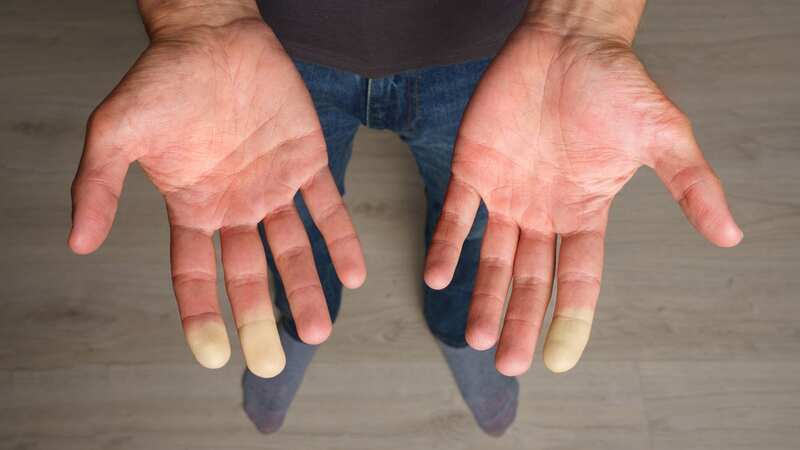'Cold hands' condition which changes the colour of fingers and toes

We all know what it's like to have cold hands, but for some people it's more than just a minor annoyance.
Millions of people with Raynaud's experience severe pain when it gets cold and their skin can change colour. This condition affects blood circulation and can cause skin colour changes - fingers and toes can turn red, blue or white. It can also be itchy and cause a burning feeling.
While fingers and toes are most commonly affected, other parts of the body, including lips and even nipples, can also be affected. Despite Raynaud's often being debilitating and affecting around one in six people in the UK, it is frequently overlooked. Now, the charity Scleroderma and Raynaud's UK (SRUK) is working to provide information to people living with the condition and fund research to find treatment and a cure.
There is no cure for the condition, but there are ways of managing it. Dr Emma Blamont, Head of Research for SRUK, has now answered the most common questions people have about Raynaud's and has come up with ways of tackling it when it attacks, reports Teesside Live.
What is Raynaud's and what causes it?
Raynaud's happens when the small blood vessels in the body's extremities, such as the fingers and toes, are overly sensitive and restrict blood flow in response to certain triggers. This reaction can be extremely painful and is known as a Raynaud's Attack. Raynaud's can't be prevented, but knowing what triggers the attacks can help stop them. Things like temperature changes, emotional shifts, stress, hormones and sometimes using vibrating tools can all cause Raynaud's attacks.
 Woman tells of losing 29 kilos and becoming a bodybuilder in her 60s
Woman tells of losing 29 kilos and becoming a bodybuilder in her 60s
In very rare cases, another condition might cause someone to show signs of Raynaud's. This is called secondary Raynaud's and it's usually linked to autoimmune diseases, where the immune system attacks healthy body tissues. But, the chances of having secondary Raynaud's are really low, as only 10% of people with Raynaud's will develop an associated condition.
 Dr Emma Blamont, Head of Research for SRUK (SRUK)
Dr Emma Blamont, Head of Research for SRUK (SRUK)Who can get it?
Anyone can get Raynaud's, but it's more common in women and girls, people under 30 and those with a low Body Mass Index (BMI). While you can't catch it from someone else, there are some cases where it runs in families. Around 10 million people in the UK have this long-term condition.
What does Raynaud's look like?
Raynaud's makes the blood vessels in parts of your body like your fingers and toes get smaller. This can be really uncomfortable and might make your skin change colour, going pale, then blue-ish, then red. This can hurt, especially when your blood vessels go back to normal and your blood starts flowing properly again. Raynaud's can also affect your lips, nose, ears and nipples in the same way.
If you think you might have Raynaud's, what should you do?
If you're showing signs of Raynaud's, it's a good idea to see your doctor. They'll check out your symptoms and look at your medical history. They might also do some blood tests (to make sure it's not something else) and other checks to find out if you have it. You can also take our quick and easy online test to see if you might have it. You can do this for free at here.
What's the treatment for Raynaud's?
If you find out you have Raynaud's, you might be given some medicine. But these aren't right for everyone because they can have side effects.
What can I do to try to stop it happening?
There are things you can do in your everyday life to help manage your condition. These can include:
- Keeping warm - wearing warm clothing in cold weather – don’t neglect your core. Layer up. Wear lots of thin layers. Use hand warmers, earmuffs, gloves and thick socks to protect your most vulnerable parts
Relaxing and pacing yourself. Stressful situations are associated with triggering attacks. Whilst it is not possible to always avoid stress there are things that can be done to help manage it, such as practising breathing techniques.
Eating healthy
Taking regular exercise
Quitting smoking. Smoking is proven to drop body temperature by up to one degree for as much as 20 minutes
 Chelsea winners and losers from record transfer window as more changes to come
Chelsea winners and losers from record transfer window as more changes to come
Avoiding repeated trauma to the fingertips
Avoidance of vibrating tools.
Controlling or limiting your emotional stress as this is a potent trigger for Raynaud’s
Where possible don’t take what are known as vasoconstricting drugs. These can include nasal decongestants, amphetamines, diet pills and SOME migraine and ADHD medications. If you believe that a medication you have been prescribed may be contributing to or worsening your Raynaud’s, do not stop taking your medication and always consult your doctor to see if there are possible alternatives.
Read more similar news:
Comments:
comments powered by Disqus

































